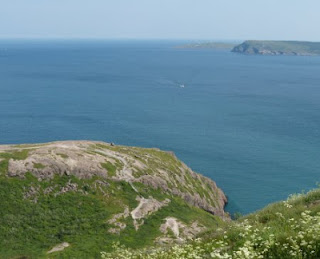






There are a lot of bugs in Hawaii. Most of them make loud, crunchy sounds as you ride over them with your bike, or accidentally squish them with your sandals. Not once have I ever thought to collect them and serve them up for dinner. The local term for delicious, "broke da' mouth", would certainly not apply to these oreo cookie sized cockroaches.
Which brings me around to the pictures above taken at a recent dinner party at our home as part of the Celebrate Science annual dinner with the authors. Each year we try to have a themed dinner for our illustrious guests. One year it was a trip to the Wine Research Centre at UBC. Another year it was the Science of Wine and Cheese where we learned that the perfect cheese to pair with Ice Wine was oddly stinky blue cheese.
It was with great trepidation and a serious amount of alcohol that a somewhat reluctant group of science lovers enjoyed some unusual appetizers or pupus as we call them on the big island.
Professor Murray Isman, Dean of Land and Food Systems fried up a pan of juvenile and mature locusts and baked a tray of meal worms for our enjoyment. The Dean's wife, Susie gave it a wide pass as she is allergic to shellfish and much to her glee, the locusts have outer coatings which contain chiton, the same material that is found in shrimp and lobster. As for taste, anything with enough garlic, butter and a dash of liqueur is pretty good. The locusts were crunchy and quite good, while the meal worms were somewhat like peanuts. They were an acquired taste.
While I might not want to serve these on a regular basis, about half the world includes insects as part of their diet. Bugs, as it turns out are the perfect food.
The average beef burger contains only 18% protein and 18% fat; the same amount of grasshopper would give you 60% protein and only 6% fat. The fat in insects is unsaturated, making them a healthier alternative to meat. Beef contains 9 mg of iron- while there is 2 mg for the same weight in grasshoppers.
Now getting into the eat locally trend, locusts can be home grown. They have a very small carbon footprint . If you raise your own they don't have to be transported over any distance by truck, train or plane. No machines are used to harvest them and obviously pesticides can't be used in raising them. They don't need steroids or additives. No questions about ethically raising these bugs and killing is done in the pan. Grasshoppers and their like are not GMO as who in their right mind would want to create cow sized bugs?
There is no shortage of these creatures around the world. Earthworms, meal bugs, locusts and other edible creepy crawlies are found in abundance everywhere. Before you get too self righteous about eating bugs, don't be so smug. Ground up bits of bugs find their way into processed foods every day. In fact you would be surprised just how many you are eating each time to have a something powdered, baked or floured.
Next year instead of carving up a roasted turkey for the holiday, try making an entree of sautéed locusts with a side of meal worms. The earth will thank you for it.
Mele Kalikimaka (Hawaiian for "Merry Christmas". The language hasn't anything for Happy Chanukah)
Location:Hawaii





























